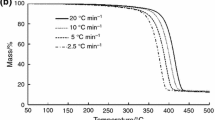Abstract
The interaction mechanism and phase evolution of ammonium polyphosphate (APP) mixed with muscovite (APP/muscovite) were studied by TG, XRD and SEM, respectively, during heating. When the temperature is not higher than 300 °C, muscovite has no effect on the thermal decomposition of APP, and the initial decomposition temperature of APP/muscovite at 283 °C is basically the same as the APP at 295 °C, and the main thermal decomposition products are polyphosphoric acid and NH4H2PO4 at 300 °C. The polyphosphoric acid, the decomposition products of APP, can enable K and Si out of muscovite and interact with muscovite chemically to generate Al2O3·2SiO2, α-SiO2 and phosphates (AlPO4 and K5P3O10) compounds during 400 °C-800 °C, which own obvious adhesive phenomenon and porous structure with the apparent porosity of 58.4%. Further reactions between phosphates other than reactions among Al2O3·2SiO2 and α-SiO2 can generate KAlP2O7 at 1 000 °C and the density of residual product is improved by low melting point phosphate filling pore to form relatively dense structure and decrease the apparent porosity to 44.4%. The flame resistant and self-supported ceramic materials are expected to enhance the fire-retarding synergistic effect between APP and muscovite.
Similar content being viewed by others
References
Chattopadhyay DK, Webster DC. Thermal Stability and Flame Retardancy of Polyurethanes[J]. Progress in Polymer Science, 2009, 34(2): 1068–1133
Samyn F, Bourbigot S, Jama C, et al. Characterisation of the Dispersion in Polymer Flame Retarded Nanocomposites[J]. European Polymer Journal, 2008, 44(6): 1631–1641
Xia Y, Jian XG, Li JF, et al. Synergistic Effect of Montmorillonite and Intumescent Flame Retardant on Flame Retardance Enhancement of ABS[J]. Polymer-plastics Technology and Engineering, 2007, 46(3): 227–232
Levchik SV, Levchik GF, Camino G, et al. Mechanism of Action of Phosphorus Based Flame Retardants in Nylon6 Ammonium Polyphosphate Talc[J]. Journal of Fire Sciences, 1995, 13(1): 43–58
Wei P, Wu D, Zhong HF, et al. Effect of Flame Retardant Containing Phosphorus and Silicone on Thermal Performance of PC/ABS[J]. Journal of Wuhan University of Technology-Mater. Sci. Ed., 2009, 24(2): 235–240
Mansouri J, Chris A, Katherine R, et al. Investigation of the Ceramifying Process of Modified Silicone-silicate Compositions[J]. Journal of Materials Science, 2007, 42(15): 6046–6055
Hanu LG, Simon GP, Cheng YB. Thermal Stability and Flammability of Silicone Polymer Composites[J]. Polymer Degradation and Stability, 2006, 91(3): 1373–1379
Mansouri J, Burford RP, Cheng YB. Pyrolysis Behaviour of Siliconebased Ceramifying Composites[J]. Materials Science and Engineering A, 2006, 425(1): 7–14
Hamdani S, Longuet C, Perrin D, et al. Flame Retardancy of Siliconebased Materials[J]. Polymer Degradation and Stability, 2009, 94(2): 465–495
Alexander G, Cheng YB, Burforda RP, et al. Ceramifying Composition for Fire Protection[P]. US Patent 0246240Al. 2007
Hanu LG, Simon GP, Mansouri J, et al. Development of Polymerceramic Composites for Improved Fire Resistance[J]. Journal of Materials Processing Technology, 2004, 153-154(1): 401–407
Zynab AH. Ceramifiable Polymer Composites for Fire Protection Application[D]. RMIT University, 2007
Zhang LY, Wei TT, Chen HJ, et al. Mechanical and Thermal Properties of Muscovite and Density Polyethylene-reinforced and -toughened Polypropylene Composites[J]. Journal of Wuhan University of Technology-Mater. Sci. Ed., 2009, 24(2): 581–587
Jiang WZ, Hao JW, Han ZD. Study on the Thermal Degradation of Mixtures of Ammonium Polyphosphate and a Novel Caged Bicyclic Phosphate and Their Flame Retardant Effect in Polypropylene[J]. Polymer Degradation and Stability, 2012, 97(3): 632–637
Ubirajara AP, Leila YV, Jorge G, et al. Flame Retardancy in Thermoplastic Polyurethane Elastomers (TPU) with Mica and Aluminum Trihydrate (ATH)[J]. Polymer Degradation and Stability, 2000, 69(3): 257–260
Wang DQ, Wang FY, Wang GX, et al. XRD Characteristics of Muscovites with Different Potassium Contents[J]. Geotectonica et Metallogenia, 2004, 28 (1):69–73
Castrovinci A, Camino G, Drevelle C, et al. Ammonium Polyphosphate Aluminum Trihydroxide Antagonism in Fire Retarded Butadienestyrene Block Copolymer[J]. European Polymer Journal, 2005, 41(9): 2023–2033
Cinausero N, Azema N, Cuest L, et al. Synergistic Effect Between Hydrophobic Oxide Nanoparticles and Ammonium Polyphosphate on Fire Properties of Poly (methyl methacrylate) and Polystyrene[J]. Polymer Degradation and Stability, 2011, 96(4): 1445–1454
Zhou Y, Hao JW, Liu GS, et al. Influencing Mechanism of Transition Metal Oxide on Thermal Decomposition of Ammonium Polyphosphate[J]. Chinese Journal of Inorganic Chemistry, 2013, 29(6): 1115–1122
Kissinger HE. Reaction Kinetics in Differential Thermal Analysis[J]. Analytical Chemistry, 1957, 29(11): 1702–1706
Zhou J. Study on the Thermal Decomposition Kinetics Models of Ammonium Polyphosphate[J]. Journal of Chinese People’s Armed Police Force Academy, 2009, 25(10): 12–15
Author information
Authors and Affiliations
Corresponding author
Additional information
Funded by the National Natural Science Foundation of China (No. 51472188)
Rights and permissions
About this article
Cite this article
Hu, S., Chen, F., Li, J. et al. Influencing mechanism and interaction of muscovite on thermal decomposition of ammonium polyphosphate. J. Wuhan Univ. Technol.-Mat. Sci. Edit. 31, 334–339 (2016). https://doi.org/10.1007/s11595-016-1372-1
Received:
Accepted:
Published:
Issue Date:
DOI: https://doi.org/10.1007/s11595-016-1372-1




